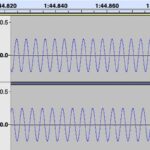People occasionally ask us whether listening to binaural beats can cause side effects.
Considering that this type of music can alter one's brain state, it is a reasonable question.
In this post, we'll take a look at how this technology works, and what, if any, the associated health risks are.
Content:
- How The Technology Works
- Binaural Beats Side Effects
- At Risk Groups
- Binaural Beats for Kids
- Listening Tips
- Summary

How The Technology Works
Binaural beats are frequencies (sound waves), which are measured in Hertz (Hz).
In their raw form, binaural beats sound like a tone, like a humming sound with a slight vibration. The pitch of the tone depends on the frequency.
More often than not there is music overlay that somewhat masks the sound of the tone.
The technology works like this: When a user puts on headphones, a frequency is sent to the left ear and a frequency is sent to the right ear.
When the brain receives the two frequencies from the left and right ears, it interprets these two different frequencies as one consistent, rhythmic frequency, known as a binaural beat(s).
The frequency it interprets is the mathematical difference between the two frequencies initially sent to the left and right ears.
So let's say we send a frequency of 205 Hz to the right ear, and a frequency of 200 Hz to the left ear, the mathematical difference is 5 Hz.
This is the frequency the brain will follow along at.
The scientific term for this process is ‘frequency following response'. It's a process that occurs naturally in the brain.
We have a guide that goes into greater depth on how binaural beats were discovered, how they work, and how you can get the most out of your listening experience. You can download that here.
But for now, let's explore what these frequencies are and whether they can harm us in any way.
Binaural Beats Side Effects
Reports of side effects from using binaural beats are extremely rare. There have been no negative reports from the numerous research studies conducted in this area.
A small percentage of users report physical effects related to the release of stress and tension in the body, such as muscle tingling during listening, and wanting to take a nap post listening.
This release is quite normal for someone who has been suffering from stress or muscular tension for sometime. Such effects are commonly reported in meditation practice.
The most dangerous thing about binaural beats is the same as it is in listening to normal music, and that is listening too loud.
Listening to sound for a long period of time at or above 85 decibels may cause hearing loss in the long term.
For reference, this is approximately the level of noise you would experience being close to heavy traffic.
One should note that turning the volume up louder than is necessary will not improve the effectiveness of binaural beats. Keep the music at a comfortable level, as you would with normal music.
Indeed, the few reports of people experiencing headaches when listening to binaural beats are most likely due to listening with headphones for too loud and or too long.
What Exactly is a Binaural Beat?
If you listen to a naked (raw) binaural beat, without a music overlay, it sounds like a humming sound with a slight pulsation.
This pulsating sound occurs when the brain combines the frequencies and the binaural beat is created, as described earlier on in this article.
If you remove one of your headphones while listening to a raw binaural beats tone – the left or right ear – you'll hear the pulsation disappear and the sound become one flat hum.
The sound waves that make up a binaural beat are nothing more than sine waves.
In music, a sine wave is a smooth repetitive oscillation: Imagine a long, flat bass note with no melody.
A sine wave is identified by the human ear as a single frequency with no harmonics.
Because binaural beats combine two sine waves, there is a subtle, recognizable harmony that occurs, along with a slight pulsation in rhythm.
The frequency pattern that creates a sine wave occurs in nature, too; in ocean waves, for example.
In short, we are accustomed to hearing frequencies like this. It is basically just a sound that lacks harmonics (any notable melody).
This is why it is highly unlikely that listening could do you any harm.
You can test listening to binaural beats on this page. Simply grab a pair of headphones and follow the instructions.
At Risk Groups
Despite there being no known side effects, there are groups that we advise not to listen to our binaural beats music.
- Epileptics
- Pregnant women
- Those wearing a pacemaker
- Those prone to any type of seizure
If you fall into one of the aforementioned categories, you should consult a physician before listening to binaural beats.
This is not because we consider the music dangerous, but because it is always best with such conditions to stay on the safe side and first seek the approval of your health provider.
Those with epilepsy are generally sensitive to changes in sound and light, and therefore this group may react to a concentrated stream of sound frequencies.
Are Binaural Beats Safe for Kids?
The short answer is yes, binaural beats music is perfectly safe for children. However, we are unable to recommend our programs to minors.
Here's why:
We get quite a few enquiries from parents asking what programs we recommend for their children, mainly for sleep, focus, and anxiety.
As an ethical business, we feel that it is most responsible to instead advise parents to seek the advice of a doctor on such issues.
Difficulty sleeping is common in adults during times of stress, aging, hormonal change among other factors. In children, however, it isn't as common and can be an indication of something more serious.
Similarly, a child experiencing anxiety could be trying to cope with a deeper issue such as bullying or self-image issues. Being unable to focus could be a sign of ADHD, or be caused by a nutritional issue.
It is therefore prudent that we advise parents to speak with their doctor. If the doctor then says it's fine for the child to use music therapy to help the issue, then great; you can choose something suitable from our catalogue.
If you do allow your children to use binaural beats programs, please note that headphone use in young children must be supervised and should only be for short periods. You should use volume-limited headphones (designed for kids) to ensure hearing safety.
Please also note that The World Health Organization advises that the maximum volume for children's headphones should be 85dB.
Listening Tips
Here's some quick listening tips for you. Remember, for more advice, you can download our free guide and check out our user FAQ.
1. Headphones
You do need headphones for binaural beats to be effective. This is because you need the left and right signal close to your ears to stimulate the brain and create the effect.
To get the most out of your listening experience, we recommend using closed-back headphones.
This type of headphone blocks out external distraction and gives you an “in-head” sound experience, without the need to turn the volume up past a comfortable level.
Open-back headphones are fine, but if you want to feel more isolated then closed-back are the better choice. You don't need to spend a fortune, though. The majority of headphones will be just fine.
2. Volume
As noted previously, you don't need the volume to be loud. Your brain will respond to the vibrations of the frequencies at a very low volume.
Set the volume to a comfortable level, whereby the sound feels soothing.
3. Create a Routine
Try starting out with three tracks a day.
Choose three tracks centered around goals you have for improvement, and listen to one session a day of each for a week.
For example, you might choose to listen to Deep Meditation in the morning, Zen Focus while at work (around 10-11am), and Deep Sleep in bed while reading a book.
Once you see positive change in a particular area, you can choose to move on and try a different recording for a different purpose.
4. Know Your Brainwaves
To generalize for ease of explanation, Delta and Theta are low frequency waves, Beta and Gamma are high frequency waves, and Alpha is somewhere in the middle.
Theta is ideal for meditation, Delta great for inducing sleep. Alpha for enhancing focus, and Beta and Gamma for stimulation of memory and energy.
We advise that you don't listen to high frequency Beta and Gamma wave tracks before bedtime, as this may cause wakefulness and affect your sleep.
5. Don't Listen While Driving or Operating Machinery
Some tracks will make you very relaxed, and we don't want any accidents to happen. So when listening, do so in a relaxed, safe environment.
In Summary
The frequencies used to create binaural beats are no different to the frequencies found in sound in general, be that in nature or manmade music.
Binaural beats are safe and sound, literally!
We hear and are exposed to sound waves (frequencies) every day, wherever we are in the world.
Therefore, the only side effects that might potentially arise from using binaural beats are those similar to over-exposure to music.
For example, if a person listens to loud music in headphones for a few hours straight they might develop a headache. This is usually only the case, however, if the headphones are too tight to the head, or the person is prone to headaches.
Additionally, over-exposure to heavy bass frequencies may cause a person to become a little nauseous. This may occur when a person stands next to a large speaker at a festival/concert for a long period of time.
Fortunately, our binaural beats music is calming to listen to and doesn't contain heavy bass sounds.
We hope this article helped put your mind at rest regarding the potential side effects of binaural beats.
In a nutshell it's just special music; music that helps your brain move into positive states of relaxation, learning, focus, creativity, healing and more.










very nice explanation
I guess being deaf in one ear due to radio oncology would make this not an option to me. Would listening with only one good ear have any beneficial effect.
Hi Bernard, you can sill benefit. Please see the following article: https://www.binauralbeatsmeditation.com/how-binaural-beats-affect-the-deaf/ Please feel free to leave any further questions you may have in the comments section of that post.
Is there any particular beat that would be best to try to improve the hearing in the one ear that works?
Hi Bernard, sorry, we don’t have a program that would improve hearing.
Hi James! my broyher listens to binaural music for healing a couple of times per day and night. we have a medium sized dog that started having epileptic fits about 8 months ago. she sleeps in their bedroom at night. the last 3 months was worisome as her fits increased to 4 per day. we took her to the Veterinary University vet hospital. they have increased the dosage of the tablets which helped for 10 days…she just had another bad one just now. He listens with good earphones, but i think the TV screen is on while he listens. Could this music acsacerbate the fits? thank you!
Hi Karin,
It could not be possible because the dog isn’t listening to the music through headphones. There is no way for the effect to take place. Could the television be a trigger? I know some people are affected by certain images and lights from the TV. Some programs actually give warnings to people who have seizures before they begin.
I’ve been using shummaan waves at 7.86 hz and sofeggio at 528. I don’t actually know if all of the recordings I listen to are binaural (not sure how that would work at higher frequencies actually). Both of these seem to have benefits, but after a few days if I stop listening to the lower frequency music before bed I have a terrible sleep . . . . is this natural?
Thanks, by the way for the explanations.
When you listen to recordings with specific frequencies, like Schumann waves (7.86 Hz) or Solfeggio tones (such as 528 Hz), your brain can enter states of relaxation or focus more easily
Hi James, it could be the case that your brain has started to “expect” the aid, almost like a routine or habit. When you stop suddenly, your brain may need time to adjust and get back to naturally producing those states without the external stimulation. This could explain the poor sleep you’re experiencing—it’s your brain readjusting to being without the lower frequencies before bed.
This isn’t harmful or unnatural; it just shows how adaptable your brain is. To ease the transition, you could try gradually reducing your listening time over several nights, rather than stopping abruptly. Alternatively, incorporating other relaxing bedtime habits (like deep breathing or a light meditation) can help.